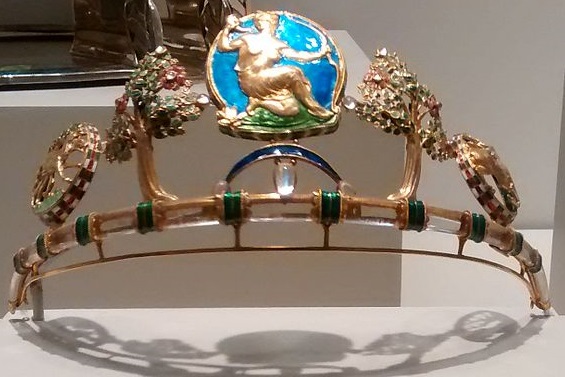| Scripture |
Additional Comments |
| |
|
| 1 For Zion's sake will I not hold my peace, and for Jerusalem's sake I will not rest, until her righteousness go forth as brightness, and her salvation as a lamp that burneth. |
|
| 2 And the nations shall see thy righteousness, and all kings thy glory; and thou shalt be called by a new name, which the mouth of Jehovah shall name. |
|
| 3 Thou shalt also be a crown of beauty in the hand of Jehovah, and a royal diadem in the hand of thy God. |
A royal diadem –
The following is from WikipediA – Diadem
The word derives from the Greek διάδημα diádēma, "band" or "fillet",[1] from διαδέω diadéō, "I bind round", or "I fasten".[2] The term originally referred to the embroidered white silk ribbon, ending in a knot and two fringed strips often draped over the shoulders, that surrounded the head of the king to denote his authority. Such ribbons were also used to crown victorious athletes in important sports games in antiquity. It was later applied to a metal crown, generally in a circular or "fillet" shape. For example, the crown worn by Queen Juliana of the Netherlands was a diadem, as was that of a baron later (in some countries surmounted by three globes). The ancient Celts were believed to have used a thin, semioval gold plate called a mind (Old Irish) as a diadem.[3] Some of the earliest examples of these types of crowns can be found in ancient Egypt, from the simple fabric type to the more elaborate metallic type, and in the Aegean world.[4]
A diadem is also a jewelled ornament in the shape of a half crown, worn by women and placed over the forehead (in this sense, also called tiara). In some societies, it may be a wreath worn around the head. The ancient Persians wore a high and erect royal tiara encircled with a diadem. Hera, queen of the Greek gods, wore a golden crown called the diadem.
"By extension, "diadem" can be used generally for an emblem of regal power or dignity. The head regalia worn by Roman Emperors, from the time of Diocletian onwards, is described as a diadem in the original sources. It was this object that the Foederatus general Odoacer returned to Emperor Zeno (the Emperor of the Eastern Roman Empire) after his expulsion of the usurper Romulus Augustus from Rome in 476 CE."

The above image found at wikimedia  |
| 4 Thou shalt no more be termed Forsaken; neither shall thy land any more be termed Desolate: but thou shalt be called Hephzi-bah, and thy land Beulah; for Jehovah delighteth in thee, and thy land shall be married. |
|
| 5 For as a young man marrieth a virgin, so shall thy sons marry thee; and as the bridegroom rejoiceth over the bride, so shall thy God rejoice over thee. |
|
| 6 I have set watchmen upon thy walls, O Jerusalem; they shall never hold their peace day nor night: ye that are Jehovah's remembrancers, take ye no rest, |
|
| 7 and give him no rest, till he establish, and till he make Jerusalem a praise in the earth. |
|
| 8 Jehovah hath sworn by his right hand, and by the arm of his strength, Surely I will no more give thy grain to be food for thine enemies; and foreigners shall not drink thy new wine, for which thou hast labored: |
|
| 9 but they that have garnered it shall eat it, and praise Jehovah; and they that have gathered it shall drink it in the courts of my Holy. |
|
| 10 Go through, go through the gates; prepare ye the way of the people; cast up, cast up the highway; gather out the stones; lift up an ensign for the peoples. |
|
| 11 Behold, Jehovah hath proclaimed unto the end of the earth, Say ye to the daughter of Zion, Behold, thy salvation cometh; behold, his reward is with him, and his recompense before him. |
|
| 12 And they shall call them The holy people, The redeemed of Jehovah: and thou shalt be called Sought out, A city not forsaken. |
|